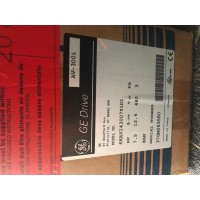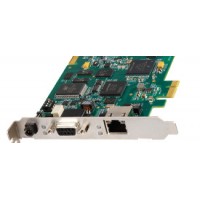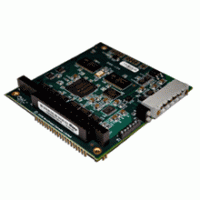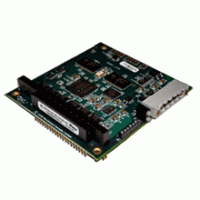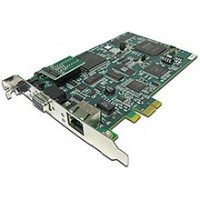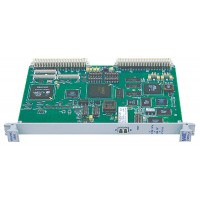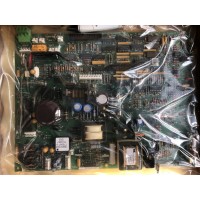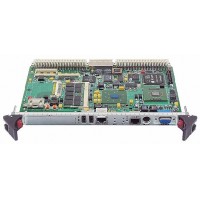品牌:GE
发货:3天内
发送询价
VMIVME-5565 Specifications
Ultrahigh Speed Fiber-Optic Reflective Memory with Interrupts
Features:
• High speed, easy to use fiber-optic network (2.12 Gbaud serially)
• Data written to memory in one node is also written to memory in all nodes on the network
• Up to 256 nodes
• Connection with multimode fiber up to 300m, single mode
fiber up to 10km
• Dynamic packet size, 4 to 64 bytes of data • Network transfer rate 43MB/s (4 byte packets) to
174MB/s (64 byte packets)
•
• 64MB or 128MB SDRAM Reflective Memory
• Two independent DMA channels
• Any node on the network can generate an interrupt in any other node on the network or in all network nodes with a single command
• Error detection for extra error suppression
• Redundant transfer mode
• No processor overhead
• No processor involvement in the operation of the network
• VMISFT-RFM2g network and shared memory driver included Operating system sup
VMIVME-5565 Ultrahigh Speed Fiber-Optic Reflective Memory with Interrupts
Fiber-Optic Cable Assemblies
A
B
C
VMICBL-000-F5
–
0
ABC = Cable Lengths
000 = .5 ft (0.15m) 011 = 350 ft (106.68m)
001 = 1 ft (.31m) 012 = 500 ft (152.15m)
002 = 5 ft (1.52m) 013 = 574 ft (175m)
003 = 10 ft (3.04m) 014 = 656 ft (200m)
004 = 25 ft (7.62m) 015 = 820 ft (250m)
005 = 50 ft (15.24m) 016 = 1,000 ft (304.30m)
006 = 80 ft (24.40m) 017 = 1,148 ft (350m)
007 = 100 ft (30.49m) 018 = 1,312 ft (400m)
008 = 150 ft (45.72m) 019 = 1,500 ft (456.45m)
009 = 200 ft (60.98m) 020 = 1,640 ft (500m)
010 = 250 ft (76.20m)
For Ordering Information, Call:
1-800-322-3616 or 1-256-880-0444 • FAX (256) 882-0859
Email: info.embeddedsystems@gefanuc.com
Web Address: www.gefanucembedded.com
Copyright © 2007 by GE Fanuc Embedded Systems
Specifications subject to change without notice.
Functional Characteristics
Introduction: VMIVME-5565 is the VME member of the GE Fanuc Embedded Systems VMIxxx-5565 family of Reflective Memory (RFM) real-time network products. The other members of the family are VMIPMC-5565, PCI mezzanine card (PMC), and VMIPCI-5565, the PCI-compatible board. All three of these products are network compatible, and may be integrated into a network in any combination. This family of products allows computers, workstations, PLCs, and other embedded controllers with dissimilar operating systems, or no operating system at all, to share data in real time.
To the local node, the Reflective Memory board appears as shared memory. Data can be written to or read from the memory by any level of software, including the application itself. Data written to the Reflective Memory in one node is transported by the network hardware to all other nodes, and placed in the same address on those node’s Reflective Memory boards. This transport of data is accomplished without the involvement of the processors on any node. Using this system, all nodes on the network have a local copy of shared data available for immediate access.
Product Overview: The Reflective Memory concept provides a very fast and efficient way of sharing data across distributed computer systems.
GE Fanuc Embedded Systems’ VMIVME-5565 Reflective Memory interface allows data to be shared between up to 256 independent systems (nodes) at rates up to 174MB/s. Each Reflective Memory board can be configured with either 64MB or 128MB of onboard SDRAM. The local SDRAM provides fast Read access times to stored data. Writes are stored in local SDRAM and broadcast over a high speed fiber-optic data path to other Reflective Memory nodes. The transfer of data between nodes is software transparent, so no I/O overhead is required. Transmit and Receive FIFOs buffer data during peak data rates to optimize processor and bus performance to maintain high data throughput.
The Reflective Memory also allows interrupts to one or more nodes by writing to a byte register. These interrupt (four levels, each user definable) signals may be used to synchronize a system process, or used to follow any data. The interrupt always follows the data to ensure the reception of the data before the interrupt is acknowledged.
Each node on the system has a unique identification number between 0 and 255. The node number is established during hardware system integration by a series of onboard switches. This node number can be read by software by accessing an onboard register. In some applications, this node number would be useful in establishing the function of the node.
link Arbitration: The VMIVME-5565 system is a fiber-optic daisy chain ring as shown in Figure 1. Each transfer is passed from node-to-node until it has gone all the way around the ring and reaches the originating node. Each node retransmits all transfers that it receives except those that it originated. Nodes are allowed to insert transfers between transfers passing through.
Interrupt Transfers: The VMIVME-5565 provides four network interrupts. Any processor can generate an interrupt on any other node on the network. In addition, any processor can generate an interrupt on all nodes on the network with a single register write.
In response to this interrupt register write, the sending VMIVME-5565 issues a special packet over the network, which contains the command strobe, the sender node ID, the destination node ID, and 32 bits of data. When a receiving node detects the proper combination of destination node ID and command strobe, it stores the sender note ID and the data in one of four 127 location-deep FIFOs. The four FIFOs correspond to the four interrupts. Upon storing this information in a FIFO, the receiving node issues an interrupt to the local processor if it has been software-enabled. The 32 bits of data stored in the FIFO is user-definable and typically is treated as an interrupt vector. As part of an interrupt service routine, the local processor reads this information out of the FIFO and acts accordingly.
Ordering Options
July 11, 2007 800-005565-000 F
A
B
C
D
E
F
VMIVME-5565
–
1
0
0
A = Memory Options
0 = 64MB
1 = 128MB
B = FIFOs
0 = Reserved
1 = 4 K FIFOs
C = Transmission Mode
0 = Multimode
1 = Single Mode
DE = 0 (Options reserved for future use)
F = Conformal Coating
0 = No Conformal Coating
1 = Conformal Coating
Simplex Cable Specifications
Fiber-Optic Cable – Multimode; (62.5 Micron core)
2
Figure 1 VMIVME-7750 Block Diagram. . . . . . . . . . . . . . . . . . . . . . . . . . . . . . . . . . . . . . . . . . . . . . . . . . . . . . . . . . . 18
Figure 1-1 VMIVME-7750 PMC and Jumper Locations . . . . . . . . . . . . . . . . . . . . . . . . . . . . . . . . . . . . . . . . . . . . . . 27
Figure 1-2 Installing a PMC Card on the VMIVME-7750 . . . . . . . . . . . . . . . . . . . . . . . . . . . . . . . . . . . . . . . . . . . . . 32
GE Fanuc Embedded Systems’ VMIVME-7807/VME-7807RC are full featured
Pentium® M-based, single board computers (SBCs) in a single-slot, passively cooled,
VME Eurocard form factor. These products utilize the advanced technology of Intel®’s

